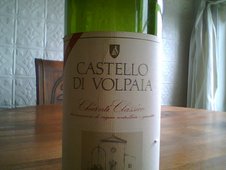Tommaso was a joy to talk to, and continued to chat with after the interview was over, while my wife and I enjoyed dinner at this place. The wife immediately took a shine to the place, which gladly lacks the glitz and pomp of most Manhattan restaurants. We may return for our anniversary with some dollars, so we can raid his low-priced collection of Barolos and Barbarescos.
Here is the text:
In the Cellar: Top Wines, Rock-Bottom Prices
Not every bottle in the three cluttered cellars of Tommaso's Restaurant, the improbably epicurean Bensonhurst haven of fine wine, is on the wine list. Owner and chef Tommaso Verdillo has received far too many gift bottles over the years to make a complete tally possible. Many of the presents have come from the winemakers themselves — offerings made during one of Mr. Verdillo's numerous tours of Italy and elsewhere.
Other estimable oenophiles have also been generous."Want to know who gave me this wine?" Mr. Verdillo said, pointing to a 1970 and a 1978 Barolo from Pio Cesare, the great Piedmont producer. "This is left over from one of Robert Parker's dinners. He just left it. I let him bring his own wines. He couldn't drink them all, and said ‘They're yours.'"
Mr. Parker, the world's most powerful wine critic, is a friend of Mr. Verdillo. "I used to meet him in Paris every January," Mr. Verdillo, a jolly figure of effusion and affability who has been known to serenade his clientele with operatic arias, said. "After he did his annual tastings in Bordeaux, we'd go on eating binges."
The critic has said Tommaso's serves possibly his favorite Italian food in America. Fairly often, the Maryland-based writer, with friends in tow, heads north for a night of choice imbibing at the eatery's windswept perch on 86th Street and Bay 8th Street.
Mr. Parker does not eat at Tommaso's simply because he is a loyal friend to the owner. He knows the same thing a lot of wine industry folks do: For top-shelf wines at rock-bottom prices, Tommaso's can't be beat. Long before the rest of the world hopped onto the Bacchus bandwagon, Mr. Verdillo decided his restaurant needed a serious wine program. He educated himself with courses in viticulture and vinification and attended early editions of Vinitaly, the Italian wine fair held every year in Verona. One by one, he befriended the great vintners of Piedmont, forging friendships with the likes of Bruno Giacosa. At a time when few people in New York cared much about Italian wines, Mr. Verdillo was investing deeply in fine vintages of Barolos, Barbarescos, and Super Tuscans.
Mr. Verdillo could charge steeply for his bottled treasures, but has chosen to keep the markup around 100% of what he initially paid (as opposed to what the wine is worth now). Thus, a magnum of Gaja Sori San Lorenzo 1990, which goes for $1,200 at the wine-centric Manhattan restaurant Veritas, can be found for less than half that amount at Tommaso's.
"If it cost me $50, I'd sell it for $100. I'd rather people drink," he said. "I'd rather share it with people. The Giacomo Conterno Monfortino 1990 for $400? That's an absolute steal! You won't find that for that price anywhere."
Of course, the bargains Mr. Verdillo uncovered in the '80s and early '90s are gone now, leading him to invest more selectively in recent vintages by his favorite makers. "Once they're gone, they're gone," he said of his cellar holdings. "I'm not buying them anymore. I don't have the clientele for it. Conterno doesn't need me to sell his wine, and I don't need to sell them at those prices."
Sometimes he despairs of the current runaway wine market. "I'm almost hurt by it. You can't share this stuff with people, it's so expensive. Wine was meant to be drunk! How can I say, You should drink this fabulous bottle of wine. But you have to give my $600 for it. It's a bargain, but you have to pay $600?'"
Even if Mr. Verdillo scraped together the money to buy a case of '89 Petrus, he said it wouldn't sell at Tommaso's. "Who's going to come here in Brooklyn to buy it?" he said. "Cru and Veritas, those are the places where people would go and spend $7,000 on a bottle."
While the customers at those restaurants may be willing to spend that kind of money, the people who work there know better; they grab the D train to the 18th Avenue stop in Bensonhurst. "The guys from Cru come here to drink," Mr. Verdillo laughed, referring to the Burgundy-rich Greenwich Village restaurant. "They raid my cellar quite often."
There is no end, in fact, to the list of wine-world heavyweights who have made the pilgrimage to Bensonhurst. Piedmont wine titan Angelo Gaja has been there many times. Bruno Giacosa's daughters have visited; one daughter roomed upstairs for a month one summer. Legendary Barolo wine producer Aldo Conterno has been a guest. The maker of the cognoscente's most favored wine glasses, Georg Riedel, dined there with his son. "He was very autocratic with that boy," Mr. Verdillo said of the Austrian glassmaker. "That kid sat up straight. Very dignified. And I'm the opposite of that. I'm not a dress-up kind of guy. Very casual." And then, of course, there are Tommaso's numerous less-celebrated regulars. "People want to drink old wines at reasonable prices," he said. "They come here for that."









